|
Often there are complaints that a novel has been changed when undergoing the transformation to the screen. This is certainly true concerning Shelley's book and the 1931 film.
What's different? Practically everything.
Set in the 1700s, Shelley's novel begins as a series of letters from Captain Walton to his sister, Margaret, while the brother is adventuring on a ship nearing the North Pole. After a huge man is sighted moving across the frozen landscape another traveler is discovered clinging to life on a piece of ice. Although we do not learn his name for some time, this is Victor Frankenstein.
While recuperating, Victor offers to tell Walton his story and the book becomes a long flashback. In the writing style of the day we are given biographical information about Victor and his family. We are introduced to his metaphysical interests and his desire to unlock the physical secrets of the world. He leaves Geneva, Switzerland to study at Ingolstadt under Professor Waldman. Waldman disabuses Victor of his interest in the alchemists he favors but cannot deter him from his desire to "unfold to the world the deepest mysteries of creation."
| 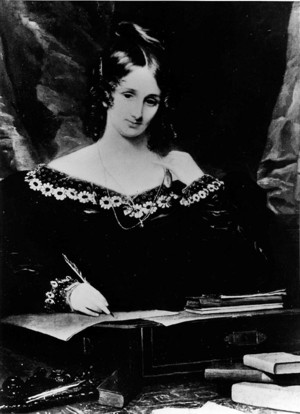 |
It comes to Victor all at once, how to bestow animation upon lifeless matter. Shelley offers no explanation how this could be accomplished and provides no details about the creation process. Suddenly, Victor has created a being, a creature with limbs in proportion, lustrous black hair and pearly white teeth, but these attributes offset by yellow skin scarcely covering the muscles and arteries, watery eyes set in dun-white sockets, a shriveled complexion and straight black lips.
It is very close to this point that the movie opens. From here it is probably better to use the film as a guide in making comparisons. After the titles, the first scene begins with a funeral. A body is buried. Hiding nearby is Henry Frankenstein with his hunchbacked assistant Fritz. In the novel Henry is the name of Victor's best friend, Henry Clerval. In the film the names are flipped around and the friend becomes Victor Moritz. Fritz does not exist in the novel; Victor employs no assistant.
Edison's Frankenstein
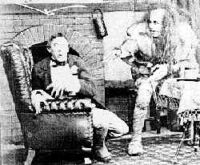 |
Once the gravedigger leaves, Henry and Fritz hurry to retrieve the freshly buried corpse "just waiting to begin a new life." On the way back to the laboratory they come across a criminal hung from a gibbet. With a broken neck this corpse is of no use. What Henry needs is a brain for his experiment.
Since Shelley's novel provides virtually no explanation of how Victor accomplishes the creation of life there is also no mention of using stitched together cadavers. Rather, because of Victor's interest in alchemy it is inferred that he has created life through some chemical means. The first known film version, the Edison Frankenstein (1910), appears to follow this concept. |
Fritz enters the classroom of Dr. Waldman, one of Henry's former teachers (as in the novel) at Goldstadt Medical School, as soon as the Doctor?s night class concludes. Waldman has been speaking that evening on the differences between a normal brain and that of a criminal, pointing out certain physical differences between the two. Fritz takes the normal brain but is frightened at the inexplicable sound of a loud gong (or is it a bedpan dropping?) and drops the glass jar to the floor. Instead, Fritz grabs the abnormal brain and returns to Henry.
Again, Shelley gives no real clues how Victor is able to create life. The need for bodies or body parts isn't mentioned, nor is the need for a brain. In the film, the abnormal criminal brain is meant to provide some reason for the creature's violent and murderous tendencies. This despite the fact that, as portrayed by Boris Karloff, the Monster (as he is often called) is frequently shown in the position of a sensitive newborn seeking nurturing attention and sympathy. In the novel, the creature is not violence prone but, rather, usually driven to act so. Although of towering height and nearly superhuman strength, the creature just wants to get along with everyone. He seeks love and companionship but due to his hideous appearance is beaten and feared. He does not appear to be inherently evil.
With a brain acquired, Henry is ready to perform his great experiment. This is to take place in his laboratory which is equipped with banks of electrical equipment. He has discovered a light beam beyond the ultra-violet range that is the key to creation. That, along with loads of electricity at a level than can only be produced by the most violent of electrical storms.
Once more, the film, as a visual medium, goes far beyond the novel in attempting to explain how Henry could create a human being. While in the novel he seems to have produced a human being in the manner that alchemists claimed to create homunculi, basically from nothing, the film deftly gives the creation a stronger scientific basis. In the novel, Victor does not require any elaborate equipment or instruments. In the first case, he works out of his room. In the second (which we will come to later) he manages in a hut on a desolate island with five inhabitants. There are no castles or stone towers serving as labs.
The night is perfect. A huge electrical storm is brewing and all the electrical equipment (the famous Kenneth Strickfaden machinery) is all in working order. There is a moment in the novel when Victor sees a tree torn asunder by lightning but it is never linked to his work. Before Henry can begin he is interrupted by his fiance Elizabeth, his friend Victor Moritz, and Dr. Waldman. They are worried about Henry and have come in a drenching rain to check on him. Their disbelief at his unrelenting obsession in his pursuit of his experiments leads him to invite them to witness the culmination of his work.
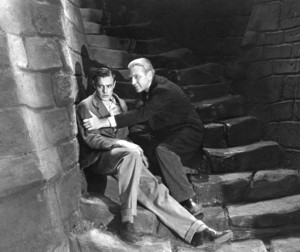
Change PermissionsReadWriteExecuteUserGroupOtherFile VersionsWarning: Restoring an older version will overwrite the current file without backing it up. New ArchiveArchive Name Back to Control PanelWeb Site .htaccess Editor Archive Gateway Disk UsagThe centerpiece of the movie is the creation scene. Whale must have recognized the spectacular quality and excitement generated by the sequence because he repeats it in Bride of Frankenstein (1935), but on a bigger scale, with more electricity and a rousing music score (by Franz Waxman) not available to him in the first film. The table with the creature is raised through a skylight in the ceiling -- one which conveniently lets none of the torrential rainstorm into the lab. The electricity does its work and the table lowered. Shortly, the creature?s hand moves.
"It's alive!" Henry shouts several times. "Now I know what it feels like to be God." This last line, declared blasphemous, was missing upon re-releases of the film (but restored for DVD). Shelley is not so daring to have Victor compare himself to God, either. Although it is implicit in his desire to create life, Shelley shies away from letting Victor literally declare himself to be like God. But Victor is never given a moment to gloat over his creation, either. He is immediately repulsed by his work and wants nothing more to do with it.
Back at the homestead, Henry's father, the Baron, now begins to wonder what's keeping his son up there in the old tower when his beautiful fiance is left alone. He suspects that there is another woman. These relationships are quite different from the ones in the novel. The Baron is a peripheral character in the novel, his interaction of little import. In the film, as played by scene stealing Frederick Kerr, the Baron is an amusing curmudgeon who provides a bit of comic relief, in the best sense. Elizabeth, however, is not only Victor's betrothed, she is also his adopted sister. In the film, no backstory for Elizabeth is provided nor is there an explanation for why she is living in the same house as her intended.
Rudy Behlmer, in his commentary for the Universal DVD release, provides another dimension to Elizabeth?s function in the film. Quoting from a Universal memo it becomes clear that Elizabeth is in love with Victor Moritz, not Henry. Her marriage to Henry is an arranged marriage, a quite common practice of the day and certainly a tradition in Europe where the film is set (although it remains vague on just where). So, though she loves Victor, she will do the honorable thing and marry Henry. This is the reason for the emphatic admonition from Henry to Victor "I leave her in your care, whatever happens. Do you understand? Your care." There is no hint of this in the novel. Besides, the comparable character, Henry Clerval, dies at the hands of the creature.
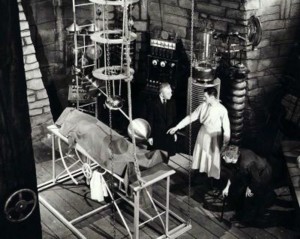
As the Baron and Elizabeth make the trek to Henry's lab Waldman predicts that the creature will kill Henry. Henry dismisses such talk, believing the creature, only a few days old, will develop as time progresses. It is then that the Monster makes his first appearance. It is not entirely logical but it is quite dramatic. For some reason (actually, to keep his features hidden), the Monster backs into the room. We see his size (of great height as in the novel) and shambling gait. Then he turns, the shortened sleeves of his jacket exaggerating the length of his thin arms. In progressively closer shock cuts we see the face, the bony brow ridge, the half-lidded eyes, at first look lacking emotion or intelligence, the sallow complexion, the surgical scars and the neck electrodes.
There is no big introductory scene in the novel and the above description doesn't quite match Shelley's but it makes a very effective substitute accomplishing the same end. In some ways, Shelley's creature with skin barely covering muscles and arteries might have been too much for audiences of the early 1930s.
Henry opens the skylight, exposing the Monster to the rays of the sun. He stands and reaches for the sunlight. Does he somehow feel a kinship with the light, unaware but instinctually responding to that which helped create him? Or does this mean that the abnormal brain is irrelevant, that in seeking the light the Monster is also seeking the good?
No matter, the skylight is closed, the Monster staring at Henry imploringly, his wavering, outstretched arms beseeching his creator. This indicates that the Monster could be turned to the good. In the novel, the creature seeks company with humans. He spends months living in a hovel attached to a cottage observing the humans within. He comes to love them and secretly perform tasks for them. The creature of the novel learns to speak (quite eloquently), read and write from these people. Karloff?s Monster can only grunt (until Bride of Frankenstein).
This hopeful moment is destroyed when Fritz crashes into the room with a torch and begins tormenting the poor creature. Later, he whips the Monster and continues to terrorize him with a fiery torch. By now, as in the novel, Henry seems to have given up on his creation, referring to the Monster as "it." Then, the Monster catches Fritz and hangs him. The creature is subdued with an injection and Waldman promises Henry that he will eliminate the creature. But the Monster revives as Waldman prepares to dismember him, strangles the doctor and escapes.
In the novel the creature is brutalized only when he attempts to interact with people. He is never chained up nor tortured with fire. The creature's tortures are more psychological as his intelligence informs him that he is unlike all others and unlikely to ever enjoy the comforts of a normal life, even the pleasure of having one single companion.
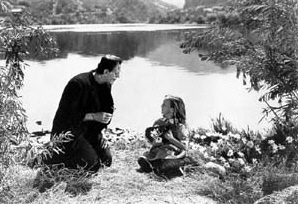
Henry retires to the family manse where preparations for his wedding to Elizabeth take place. The Baron has provided free beer to the town and soon a major celebration is underway.
Down by the lake, little Maria is left alone by her father, Tom. The Monster discovers the little girl who, in her innocence, does not recognize the potential danger and invites him to play. She is throwing flowers into the lake and watching them float. This spectacle thrills the Monster as he joins her, tossing flowers into the water with delight. But when he runs out he picks up Maria, and despite her protests, tosses her into the water. She drowns and the Monster, aware of something horrible yet still uncomprehending, stumbles away blindly through the trees.
In the novel the opposite happens. The creature rescues a young girl from drowning after she falls into a raging river. Pulling her to safety, a man discovers them and beats the hapless creature.
As the wedding preparations continue, Elizabeth reveals to Henry a sense of foreboding, that something is going to happen. About then, Victor hurries in to tell Henry that Waldman is dead and the Monster seen terrorizing the mountainside. Henry locks Elizabeth in her room and, believing the Monster in the house, a search is conducted.
The Monster is indeed in the house. He climbs through the window of her bedroom. This retains in visual form the threat uttered by the creature in the novel that "I will be with you on your wedding night." Elizabeth screams and the Monster leaves just as Henry and Victor get to her room.
In the film Elizabeth has merely swooned. In the novel, the creature murders Elizabeth on her wedding night. While the film depicts the Monster as merely a sort of beast that runs amuck, more frightened than malevolent, in the novel the creature's acts of violence are perpetrated as revenge against Victor for, first, deserting him, and, second, not creating a bride for him. The creature plans to inflict suffering on Victor by killing everyone he loves.
e FTP FilTom walks zombie-like through the streets of the town, the wet, dead body of his daughter dangling in his arms. At the Burgomaster?s house he declares that she was murdered (although we can't be sure how he knows this). Every able bodied man in town is recruited to hunt down the murdering fiend, including Henry.
In the mountains, Henry finds his creation. Overpowered, he is carried to an old windmill. Soon the torch bearing villagers surround the structure. When Henry tries to escape the Monster catches him and tosses him from a platform onto one of the windmill blades. The villagers take Henry away and set fire to the building. They stay there a long time watching the wooden windmill as it is consumed by flame.
In the end all is well. Henry and Elizabeth are reunited and the Baron is in good spirits. Quaffing a draft of his grandmother's wine he toasts, "Here's to a son, to the House of Frankenstein." Who could know that there would be both a Son of Frankenstein (1939) and a House of Frankenstein (1944).
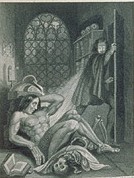
1832 edition illustration.
Frankenstein flees from his creation.
The novel proceeds in an entirely different direction. Victor is confronted on a mountainside by his creation. The creature pours out his short life story to this point, how he wandered away unawares that he had a creator, discovered the cruelty of humans, withstood the ravages of cold and heat, spent months in the aforementioned hovel learning to speak, read and write and then having his dreams of joining a family dashed. Then, his discovery of Victor's journal in the coat he had taken the night he left, learning where Victor's family lived, and his pledge to cause Victor as much pain and suffering as possible. Unless Victor creates a bride for the creature. At first Victor can't be budged. The thought of creating another such creature is too much for him. However, the thought that the creature would forever quit the civilized environs of the Earth and, especially, leave Victor, his family and friends alone is too appealing. He agrees and after a long delay travels to a desolate island in the Orkney's where he works on a bride in a two room hut.
His better self prevails, though, and as he nears completion of the project he looks up to see the creature staring at him through the hut window. Immediately, he tears to pieces the creation before him. The creature runs into the night wailing.
As the creature continues its killing spree -- some deaths are incidental, like that of the old Baron who dies from a heart attack -- Victor resolves to track the creature down and kill it or be killed. His journey leads to the frozen North where the account of his story ends.
Captain Walton's ship faces destruction from the crushing force of encroaching ice mountains. The crew fears for their lives and threatens a mutiny unless he promises to return them to warmer, safer climes. Victor wishes to go on, regardless of their decision but expires in bed. Entering Victor's cabin Walton discovers the distraught creature full of recrimination and sorrow at his creator's death. The creature promises to travel northward and prepare a funeral pyre from which his ashes will give no one a clue to his being. He exits through the window to his ice raft and is lost in the darkness. The end.
Bride of Frankenstein
Some elements from the novel that weren't used in the first film found their way into the second, Bride of Frankenstein. For one, Henry agrees to create a second creature, a bride for the Monster. Unlike the novel, Henry actually goes through with the experiment, succeeding brilliantly, but failing to produce a companion for his original creation. The interlude in the forest, when the creature lives in a hovel attached to a cottage gets some mileage in Bride.
Specifically, one of the inhabitants of the cottage was the blind father. One day when everyone else is way, the creature takes a chance and enters the cottage hoping that the old man, unable to see his horrible appearance, will respond to his voice and entreaties. The old man seems sympathetic but the untimely return of the family spoils everything.
In Bride there is also a blind man. When the Monster happens upon him he responds gently with kindness. The Monster is calmed by the first real acceptance he has experienced. He is not turned out and begins to enjoy some of the simplest of human pleasures such as good food, wine, a cigar and a warm fire. In the short time they have together the blind hermit is also able to teach the Monster enough words to allow him to communicate verbally. Of course, this brief respite cannot last long and soon the Monster is on the run again.
Peggy Webling's stage version of Frankenstein was a greater influence on the film's plotline than the novel. John L. Balderston who, with Hamilton Deane, had written the play upon which Universal's production of Dracula (1931) was based, in turn adapted Webling's play, which was then scripted by Francis Edward Faragoh and Garrett Fort, another writing alumnus of Dracula. The result was far from Shelley, yet produced a film that is still "alive," watched and studied today.
|










